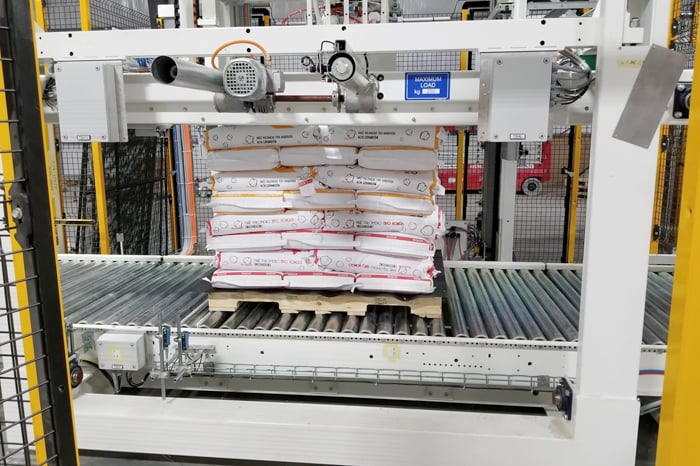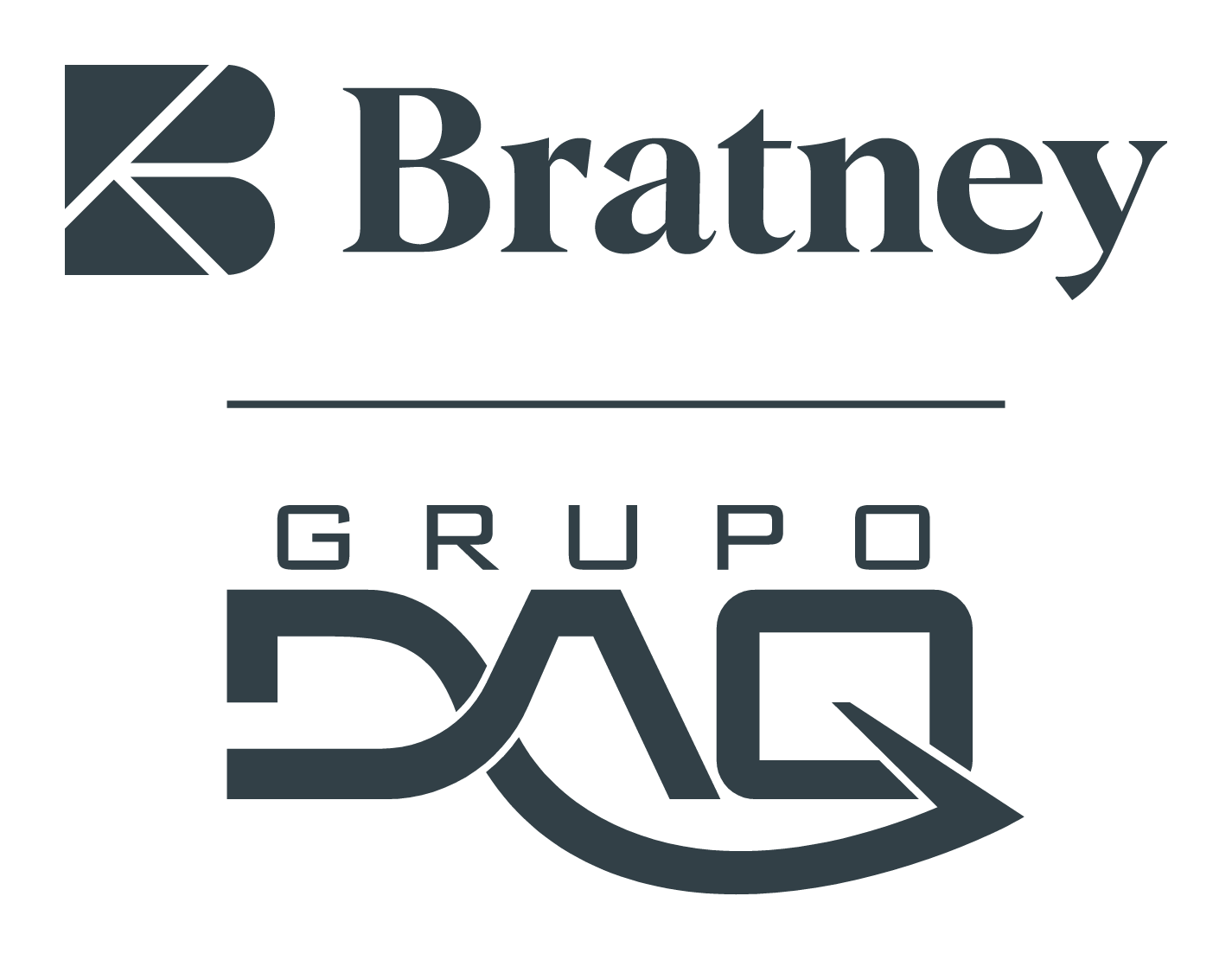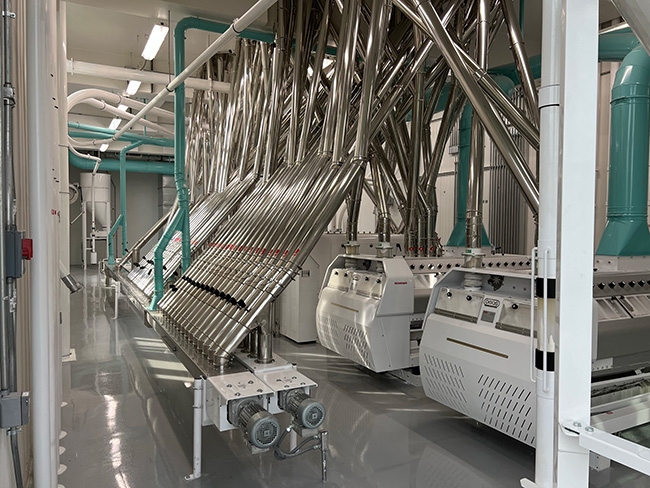
What is a Palletizer?
A palletizer is a machine that helps to automate palletizing operations. It is designed to palletize product boxes, bags, cases, and other materials onto pallets efficiently and quickly. Palletizers are used in various industries such as transportation, food production, pharmaceuticals, warehousing and more. They can work autonomously or in conjunction with additional packaging solutions you may need. Automatic palletizers are increasingly popular due to their reliability and employers efforts to reduce workplace injuries from repetitive heavy lifting.
Types of Palletizers
There are several types of automated palletizer machines available, each offering different benefits and features depending on the specific application. The most common automatic palletizers are robotic palletizers, conventional palletizers, and hybrid-robot palletizers.
Robotic palletizers offer incredible flexibility. With specialized end tooling robot palletizers can stack bags, boxes, crates and bales from one or multiple infeed conveyors. They can build any layer pattern required, including overlapping bags to build a tight, stable pallet. Robotic palletizers are highly customizable and can be designed to meet specific palletizing needs ranging from semi-automatic operation where forklift drivers place single pallets into the robot cell or fully automated with pallet dispensing, slip sheet dispensing and automated pallet conveyors. Their main disadvantage compared to other types of automatic palletizers are speed limitations and the lack of side squaring and layer compression.
Conventional palletizers, or ‘push-type’ palletizers work by forming partial layers on a layer-squaring plate. Once the full layer of bags is on the layer squaring plate, all four sides of the layer are held in place (side squaring) and doors under the layer open to allow the complete layer to drop onto the pallet below. This squaring effect builds an incredibly uniform and precise pallet. Conventional palletizers come in two varieties, high-level and low-level and they work mostly the same way with their main difference being palletizing speed. High-level palletizers can stack twice as fast as low-level machines. The main disadvantage of a conventional palletizer compared with other types of automatic palletizers is limited flexibility and limited options for layer patterns. Conventional palletizers do not pick up individual bags, they slide them into place. Therefore, if an application requires bag overlap in the layer in order to fit within the dimensions of the pallet another type of palletizer must be used.
Hybrid-robot palletizers marry the best features of a robotic arm palletizer with the best features of a conventional palletizer into one unit. They include a robot-style end tool that picks and places each bag. They also include the layer squaring and layer compression benefits of a conventional palletizer. These two combined make them unique having the flexibility of a robot to overlap bags and build any layer pattern necessary, but also the uniform, compact pallet of a conventional palletizer.
Choosing The Right Palletizer For Your Application
When selecting a palletizer machine, it is important to consider your palletizing needs and the environment in which the palletizer will be used. The type of palletizer you need depends on the available space in your facility, the dimension, contents, and weight of your product, and the palletizing speed and layer patterns required.
Types of Palletizers
Bratney offers palletizers of all types and sizes including robot, hybrid-robot, high-level and bag-in-box palletizers. Our packaging division is highly skilled in understanding your entire palletizing application and recommending solution(s) that are customized to your application. This approach provides unmatched stack quality, system uptime and ease of use for operators. If you need to palletize, bags, boxes, cases, or bundles we can help.
Robotic Palletizers
Robotic palletizer machines provide automation and flexibility in a compact package. Robotic palletizers can stack many different products, produce any pallet pattern, and overlap bags. Robotic palletizer machines can be configured for simple, single pallet applications or with full automation to palletize products from several bagging lines to one or more pallets.
Hybrid-Robotic Palletizer
Our packaging partner, Concetti, was the first to develop this innovative category of palletizers and now makes two versions: the four-column palletizer, the original hybrid-robotic palletizer, and the Lampo palletizer. Both combine the flexibility of a traditional robotic palletizer with the speed and perfect pallet shape of a high-level palletizer machine. They are the ultimate combination of high-speed palletizing and the highest quality pallet stack available and the Lampo’s unique end tooling can handle bags, boxes, and bundles.
High-Level Palletizer
High-level or push-type palletizer machines provide unmatched speed with extremely square and flat layers producing stable and perfectly square pallet loads. High-level robotic palletizer machines are well suited for almost any type of bag requiring a flat layer pattern and can also stack boxes. High-level palletizer machines are also very simple, requiring very little maintenance.
Low-Level Palletizer
The low-level palletizer utilizes squaring plates and layer top compression to produce stable and perfectly square pallet loads nearly identically to a high-level palletizer. However, their infeed system works slightly differently and therefor they can’t run as fast as a high-level machine. Low-level robotic palletizer machines work well in applications requiring medium speeds and flat-layer patterns.
Bag-In-Box Palletizers
This robotic palletizer machine can stack a wide range of products including bags, boxes, trays, and bundles and can also place products into pre-made display cartons or shipping boxes. The compact footprint makes it well-suited for tight spaces. Bags can be placed in any position on the pallet, it is possible to create an overlap, providing excellent stability and geometry to the palletized load, regardless of the bag's shape and type.
Case Palletizers
Robotic case palletizer machines stack cases and cartons on pallets and pre-formed trays. This solution is perfect for packing retail-ready cartons on pallets or into display trays. These systems can be equipped with vacuum and servo-adjusted end tooling to place the product, slip sheets, and interlayer sheets. Consider integrating case palletizers upstream for a truly automated carton palletizing system.
Robotic De-Palletizer
Robotic de-palletizing systems provide automation and efficiency by de-palletizing bags, boxes, or cartons onto outfeed conveyors for ensuing production steps. These products work great in conjunction with bag-breaking stations to automatically empty the contents of the bag into a material handling system or bin. Advanced end-tooling options are designed for each specific application, ensuring the de-palletizer works flawlessly.
Choosing the Right Palletizer
Choosing the right palletizer for your application is important for ensuring efficient and reliable operation. Depending on your specific needs, you should consider factors such as product size, weight, speed requirements, and the type of palletizing pattern that needs to be achieved to find the best solution for your application. You need to also be mindful of your available space to add these solutions into your facility as well as future scaling goals you may have.
Robotic palletizer machines provide unmatched flexibility and speed, while high-level palletizers offer exceptional stack quality. Low-level palletizers are a great option for medium speeds and bagging lines, while specialized bag-in-box or case palletizers can be used to further enhance the palletizing process. Ultimately, it is important to consider allthese factors to find the right palletizing solution for your application and work with aknowledgeable provider to help you get these details right.
Benefits of Investing in an Automated Palletizing System
By investing in an automated palletizing system, you can improve safety, reduce labor costs, and increase efficiency throughout your production line. This will enable you to produce higher-quality products at a faster rate while eliminating the dangers associated with manual palletizing. A well-designed automatic palletizing system will provide you with trouble-free operation for decades and have an ROI in as little as a few years.
Contact us today to get more insight into how you can get started with palletizing machines.


